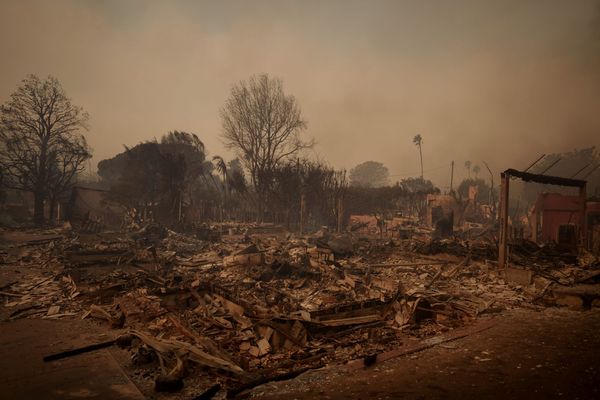
The architect Christopher Alexander, who has died aged 85, saw buildings and cities as living frameworks for human beings. Through designing, building, teaching and writing, he sought “to provide a complete working alternative to our present ideas about architecture, building and planning”.
Like many critics of postwar reconstruction, he saw much that was destructive of community and incapable of elevating the human spirit, and set about a systematic approach to making buildings in which people could feel at home. He wanted to identify the order that lies behind beauty and meaning in the built world, and then learn, as an architect and builder, how to make it. I knew him as a teacher, colleague and mentor.
A housing project in the barrios of Lima, the capital of Peru, in 1969 began with his team living for five weeks with different families on site, observing the details of daily life, to develop a what he called a “pattern language” of 67 principles that formed the basis for the design.
In a housing project in Mexico in 1975-76 built with steel-reinforced soil-cement blocks and roof vaults of lightweight concrete, families laid out their own houses on the site, and participated in their construction, developing details as the work proceeded. This direct and detailed involvement of both architect and client served to promote a more accurate outcome.
His approach provided the basis of an architecture bestseller, A Pattern Language (1977). Each of 253 “patterns”, with its own number, describes a helpful relationship between parts of the environment, and consists of a title – such as Public Outdoor Room, South Facing Outdoors or Windows Overlooking Life – explanatory text, diagrams and photographs. The patterns are linked to each other in a network structure, which gave the book an appeal to the software developers among its general readership.

More and larger projects followed – a marketplace and a shelter for homeless people in San Jose, California (1990), the West Dean visitors’ centre in West Sussex (1994-96), an apartment building in Tokyo (1988), a series of houses in California and Washington state, and many others.
In them, Chris tried to achieve buildings that are alive and at peace with themselves, what he called “the quality without a name”, as described in his book The Timeless Way of Building (1979).
He developed detailed understandings of places, activities and forms at a range of scales and in relationship to each other, and his projects always incorporated construction innovations, ranging from walls made with interlocking soil-cement blocks laid without mortar, to walls made with local flint along with concrete and brick, to digital techniques that aided the design of large timber-framed buildings in Japan.
Many of Chris’s sources came from traditional and vernacular buildings, leading some people to see him as old-fashioned or nostalgic. But to him, those buildings were not to be copied, but used to bring to light principles of order that he saw as lacking in contemporary architecture. His was not a reaction against style, but a recognition of the recurrent structure of beautiful buildings and places. His collection of old Turkish carpets contributed to his last major set of books, The Nature of Order (four volumes, 2002-04).
Perhaps his most significant project was the Eishin high school, outside Tokyo, designed and built in the early 1980s. A months-long process of involvement with the school’s teachers, staff and students resulted in a project-specific pattern language addressing the several dozen features of the school that the clients saw as most important.
Working on the site itself transformed that idealised picture into something that took advantage of the site’s hills and water, while maintaining the essence of the core ideas. And the process of making it brought together Chris’s team with that of a large construction company, working with local craftsmen who did much of the carpentry and the shikkui plaster on the walls of the buildings.
The project won awards and was enjoyed by the teachers and students. The buildings and gardens have a strong sense of place, and much of the quality of traditional Japanese building. But it was also large and complex enough to reveal incompletely answered questions: how to reconcile a highly interactive process of design and building, attentive to the emerging feeling of the place, with the practicalities of budget, timeline and the norms of construction. Nonetheless it represents a major achievement.
It incorporated the earlier idea of pattern languages as a way of being explicit about human needs in the environment with a later, more inclusive set of ideas about beauty and wholeness – ideas that indeed stretched beyond architecture to the sciences, particularly biology and cosmology.
Born Wolfgang Christian Johann Alexander in Vienna, Austria, Chris was the son of Lilly (nee Deutsch) and Ferdinand Alexander, both classical archaeologists. In 1938 Nazi Germany annexed Austria, and the family moved to Britain.
Chris’s father told him that if he wanted to study architecture, he first needed to study something more intellectually rigorous. So he took degrees in mathematics and architecture at Trinity College, Cambridge, and in 1958 went to Harvard University, where he took the first PhD in architecture awarded there. In 1963 he was appointed to the architecture faculty at the University of California, Berkeley, and remained there until returning to Britain early in the new century.
To many architects and faculty colleagues at Berkeley, Chris violated the conventional wisdom that beauty is subjective and to talk about it is overly sentimental. Working with him was not always easy, but the fact that everyone’s comments were always taken seriously helped make the effort worthwhile. Chris realised that the smallest hint of unease about an idea might be the sign of something important.
The office that he founded in 1967, the Center for Environmental Structure, was always small, with a half dozen or so people. Projects were taken up for the opportunity to experiment and advance the theoretical work rather than to maintain cashflow. Chris saw his most important role as that of a writer, and in an age of upheaval his ideas of simple beauty and the need to support the basic humanity of people may become even more influential.
In 1980 he married Pamela Patrick, and they had two daughters, Lily and Sophie. The marriage ended in divorce in 2007, and the following year he married Maggie Moore. She and his daughters survive him.
• Christopher Alexander, architect, academic and writer, born 4 October 1936; died 17 March 2022







